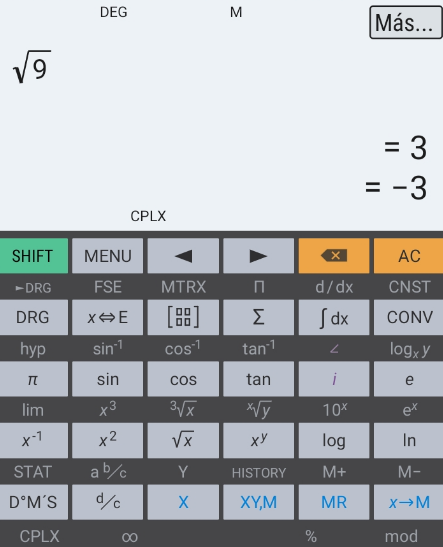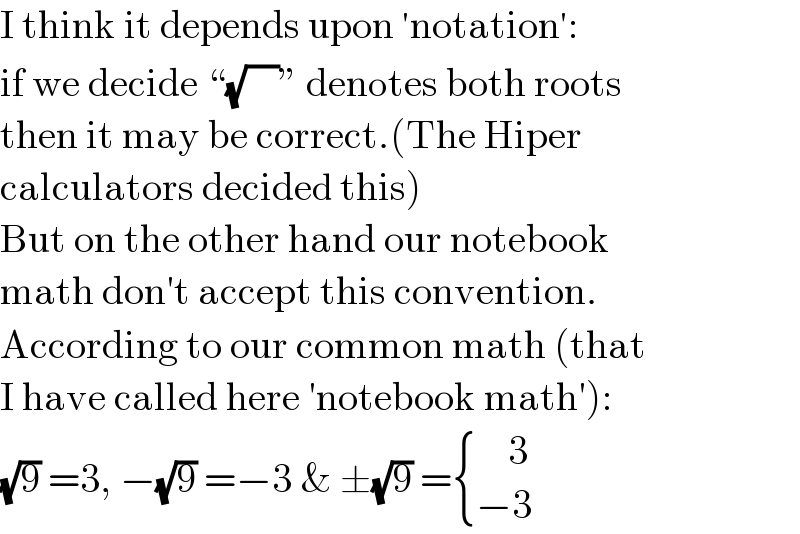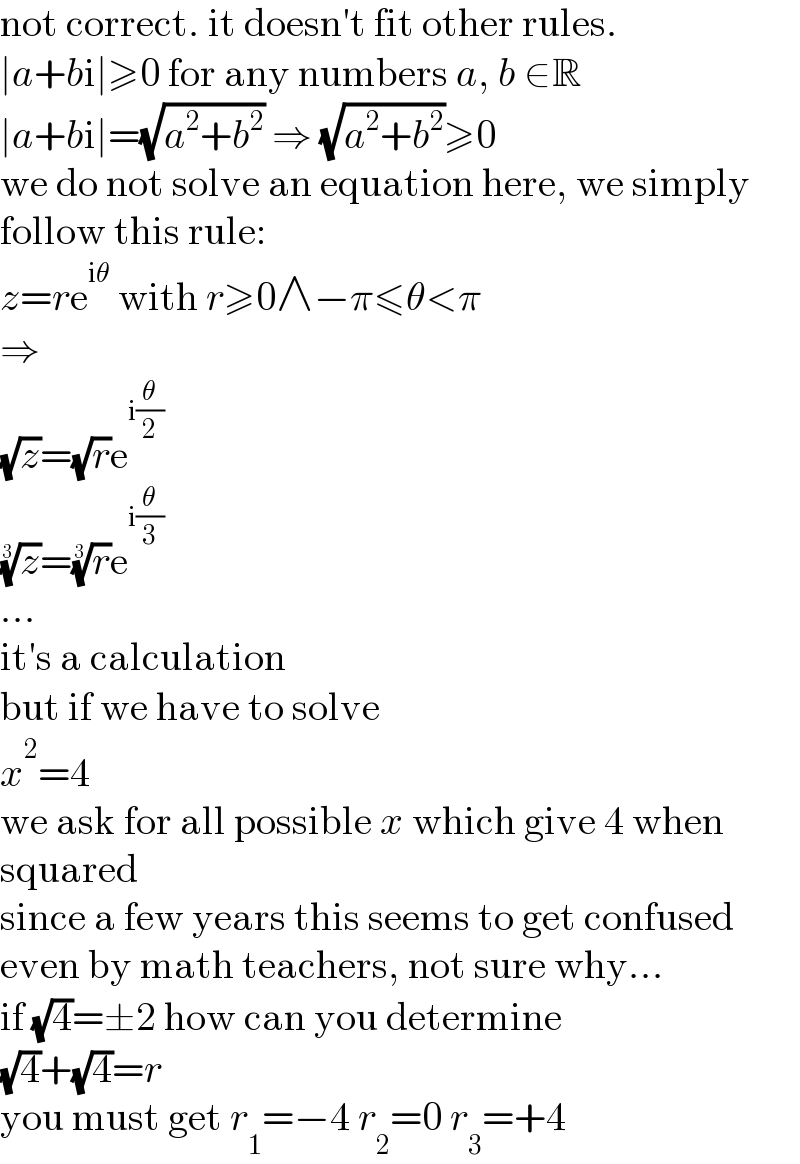
Question Number 179064 by HeferH last updated on 24/Oct/22

Commented by HeferH last updated on 24/Oct/22

$${is}\:{this}\:{correct}? \\ $$
Commented by Rasheed.Sindhi last updated on 24/Oct/22

$$\mathrm{I}\:\mathrm{think}\:\mathrm{it}\:\mathrm{depends}\:\mathrm{upon}\:'\mathrm{notation}': \\ $$$$\mathrm{if}\:\mathrm{we}\:\mathrm{decide}\:``\sqrt{\:\:\:\:}''\:\mathrm{denotes}\:\mathrm{both}\:\mathrm{roots} \\ $$$$\mathrm{then}\:\mathrm{it}\:\mathrm{may}\:\mathrm{be}\:\mathrm{correct}.\left(\mathrm{The}\:\mathrm{Hiper}\right. \\ $$$$\left.\mathrm{calculators}\:\mathrm{decided}\:\mathrm{this}\right) \\ $$$$\mathrm{But}\:\mathrm{on}\:\mathrm{the}\:\mathrm{other}\:\mathrm{hand}\:\mathrm{our}\:\mathrm{notebook} \\ $$$$\mathrm{math}\:\mathrm{don}'\mathrm{t}\:\mathrm{accept}\:\mathrm{this}\:\mathrm{convention}. \\ $$$$\mathrm{According}\:\mathrm{to}\:\mathrm{our}\:\mathrm{common}\:\mathrm{math}\:\left(\mathrm{that}\right. \\ $$$$\left.\mathrm{I}\:\mathrm{have}\:\mathrm{called}\:\mathrm{here}\:'\mathrm{notebook}\:\mathrm{math}'\right): \\ $$$$\sqrt{\mathrm{9}}\:=\mathrm{3},\:−\sqrt{\mathrm{9}}\:=−\mathrm{3}\:\&\:\pm\sqrt{\mathrm{9}}\:=\begin{cases}{\:\:\:\:\mathrm{3}}\\{−\mathrm{3}}\end{cases} \\ $$
Commented by MJS_new last updated on 24/Oct/22

$$\mathrm{not}\:\mathrm{correct}.\:\mathrm{it}\:\mathrm{doesn}'\mathrm{t}\:\mathrm{fit}\:\mathrm{other}\:\mathrm{rules}. \\ $$$$\mid{a}+{b}\mathrm{i}\mid\geqslant\mathrm{0}\:\mathrm{for}\:\mathrm{any}\:\mathrm{numbers}\:{a},\:{b}\:\in\mathbb{R} \\ $$$$\mid{a}+{b}\mathrm{i}\mid=\sqrt{{a}^{\mathrm{2}} +{b}^{\mathrm{2}} }\:\Rightarrow\:\sqrt{{a}^{\mathrm{2}} +{b}^{\mathrm{2}} }\geqslant\mathrm{0} \\ $$$$\mathrm{we}\:\mathrm{do}\:\mathrm{not}\:\mathrm{solve}\:\mathrm{an}\:\mathrm{equation}\:\mathrm{here},\:\mathrm{we}\:\mathrm{simply} \\ $$$$\mathrm{follow}\:\mathrm{this}\:\mathrm{rule}: \\ $$$${z}={r}\mathrm{e}^{\mathrm{i}\theta} \:\mathrm{with}\:{r}\geqslant\mathrm{0}\wedge−\pi\leqslant\theta<\pi \\ $$$$\Rightarrow \\ $$$$\sqrt{{z}}=\sqrt{{r}}\mathrm{e}^{\mathrm{i}\frac{\theta}{\mathrm{2}}} \\ $$$$\sqrt[{\mathrm{3}}]{{z}}=\sqrt[{\mathrm{3}}]{{r}}\mathrm{e}^{\mathrm{i}\frac{\theta}{\mathrm{3}}} \\ $$$$... \\ $$$$\mathrm{it}'\mathrm{s}\:\mathrm{a}\:\mathrm{calculation} \\ $$$$\mathrm{but}\:\mathrm{if}\:\mathrm{we}\:\mathrm{have}\:\mathrm{to}\:\mathrm{solve} \\ $$$${x}^{\mathrm{2}} =\mathrm{4} \\ $$$$\mathrm{we}\:\mathrm{ask}\:\mathrm{for}\:\mathrm{all}\:\mathrm{possible}\:{x}\:\mathrm{which}\:\mathrm{give}\:\mathrm{4}\:\mathrm{when} \\ $$$$\mathrm{squared} \\ $$$$\mathrm{since}\:\mathrm{a}\:\mathrm{few}\:\mathrm{years}\:\mathrm{this}\:\mathrm{seems}\:\mathrm{to}\:\mathrm{get}\:\mathrm{confused} \\ $$$$\mathrm{even}\:\mathrm{by}\:\mathrm{math}\:\mathrm{teachers},\:\mathrm{not}\:\mathrm{sure}\:\mathrm{why}... \\ $$$$\mathrm{if}\:\sqrt{\mathrm{4}}=\pm\mathrm{2}\:\mathrm{how}\:\mathrm{can}\:\mathrm{you}\:\mathrm{determine} \\ $$$$\sqrt{\mathrm{4}}+\sqrt{\mathrm{4}}={r} \\ $$$$\mathrm{you}\:\mathrm{must}\:\mathrm{get}\:{r}_{\mathrm{1}} =−\mathrm{4}\:{r}_{\mathrm{2}} =\mathrm{0}\:{r}_{\mathrm{3}} =+\mathrm{4} \\ $$
Answered by thenxtkvng last updated on 24/Oct/22

$${since}\:\mathrm{3}×\mathrm{3}=\mathrm{9} \\ $$$$\therefore{the}\:{square}\:{root}\:{of}\:\sqrt{\mathrm{9}} \\ $$$${is}\:\mathrm{3} \\ $$
Commented by MJS_new last updated on 24/Oct/22

$$\mathrm{but}\:\mathrm{also}\:\left(−\mathrm{3}\right)×\left(−\mathrm{3}\right)=\mathrm{9} \\ $$$$\mathrm{your}\:\mathrm{explanation}\:\mathrm{is}\:\mathrm{not}\:\mathrm{good} \\ $$
